I'm very interested in the various forms of bloodroot, Sanguinaria canadensis. I don't have much in the way of bloodroot in my garden, but I hope to remedy this situation. A couple years ago I went in "halfsies" (slang for splitting the cost) with a friend for a great pot full of Sanguinaria canadensis 'Multiplex'.
The distribution of this plant is quite succinctly eastern half of North America:
http://www.efloras.org/object_page.aspx?object_id=5418&flora_id=1
They're coming up now, and I'm fascinated by the early leaf-bud form, looking like little people wrapped in shalls, the enveloping leaves membranous and with raised veins, I also get the impression of bat wings wrapped tight around their resting bodies. I hadn't noticed before, but the buds are initially tinged with pink. I am showing 4 views, taken in two different light conditions.
If others have photos of the other flower forms, please post them here, things like the "Tennessee Form".
Comments
Re: Bloodroot - Sanguinaria canadensis
Thanks for the comment on the photos, my wife and I are sharing a new Canon Powershot ELPH 300HS camera; soooOOOO much better than my phone-camera.
The small disjunct South Dakota populations look to be in the Black Hills area.
The Calphotos link shows lots of variability, in both flower form and the leaves. After the main page, click the link for the next 16 photos, there's one leaf form there that does a remarkable inpersonation of twinleaf or Jeffersonia diphylla, or use this link:
http://calphotos.berkeley.edu/cgi/img_query?enlarge=0000+0000+0708+0847
Re: Bloodroot - Sanguinaria canadensis
Mark mentioned the 'Tennessee Form', which I find particularly lovely:
I'm starting to grow a few other (hopefully) distinct forms, namely 'Don Armstrong', 'Edith Dusek', a dwarf form (which is tiny indeed) from Aaron Floden, and another form that Aaron describes as a particularly vigorous collection from Hurtsboro, AL.
Mark, that's some remarkable foliage in the calphotos database--thanks for sharing!
Re: Bloodroot - Sanguinaria canadensis
Beautiful photo, Macjon! That certainly is a lovely form, and I hope you will show the other ones you're growing as well.
Re: Bloodroot - Sanguinaria canadensis
Thanks Macjon, I need to get the Tennessee form, I know that Garden Vision Epimedium has sold it in years past, but by the time I select all the epimediums I want, I'm already "in the red", and no money left for non-epimediums. ;)
I just looked up the other forms you mention, and the one named 'Edith Dusek' is available from Far Reaches Farm. Evidently Jerry John Flintoff found this particular form, which he named for Washington trillium expert Edith Dusek (I became friends with Mr. Flintoff when I lived in Seattle, and visited the wonderful garden of Edith Dusek). Here's the nursery link:
http://www.farreachesfarm.com/Sanguinaria-canadensis-Edith-Dusek-p/p1173...
Re: Bloodroot - Sanguinaria canadensis
My Sanguinaria canadensis 'Multiplex' has a pink tinge this season, too. And also the first time I noticed: when I took this pic four days ago. I am finding deeper color than "normal' in lots of things this spring - pulsatilla, pulmonaria, corydalis, cardamine. I really don't understand why, because it has been so warm.
Re: Bloodroot - Sanguinaria canadensis
Interesting thread. I tried to establish bloodroot in my garden for several years before I had luck with rhizomes from a friend and in somewhat heavier soil. I think one is the ordinary form and another the multiplax form. I'll take a look when I'm back home. They've stood ready for flowering for 10 days without opening the flowers due to lack of warm weather.
Re: Bloodroot - Sanguinaria canadensis
Lis,
Typical bloodroot flowers have 8 petals (or 8-12 petals depending on the form). The one called Tennesssee Form is one that has 12 or more petals, thus considered a semi-double.
Checkout John Lonsdale's bloodroot photo galleries Edgewood Gardens, amazing variability, and of course, all beautifully photographed. He has some great photos of the pink form too.
http://www.edgewoodgardens.net/Plants_album/The%20Plants%20-%20%20Complete%20Collection/Papaveraceae/Sanguinaria/index.html
Two photos from the Alpine Garden Soiciety website (from John Lonsdale's photos) illustrate it well, in this link we see typical 8-petaled flowers, notice in outline they forma square profile.
http://www.thealpinegarden.com/sanguincantriple.htm
Here is the so-called semi-double "Tennessee Form, with 12-16 petals:
http://www.thealpinegarden.com/sanguinTNform.htm
Wow, look at this one on John's pages, it is called 'Paint Creek Double'
http://www.edgewoodgardens.net/Plants_album/The%20Plants%20-%20%20Comple...
Re: Bloodroot - Sanguinaria canadensis
This is my Sanguinaria-form, in Holland called S.canadensis 'Flore Pleno'. Sometimes called 'Multiplex'.
Is it the same, Mark, as yours? I think I see little differences.
Re: Bloodroot - Sanguinaria canadensis
This is my Sanguinaria-form, in Holland called S.canadensis 'Flore Pleno'. Sometimes called 'Multiplex'.
Is it the same, Mark, as yours? I think I see little differences.
I do think it is the same plant. There was a combination published in 1931 as S. canadensis f. multiplex, but the species is so variable and includes double forms, I don't think the name is recognized officially, thus the plant goes around as 'Multiplex', 'Fora Plena' or 'Flora Pleno".
Here's a web site with good information and some excellent photos:
http://www.sanguinaria.nl/indexEN.html
Re: Bloodroot - Sanguinaria canadensis
Lovely plants, though I prefer the singles, or maybe semi-doubles :) Pink would be cool!
I haven't got any yet, will have to watch for seed, I guess Kristl should have it.. I've noticed Richter's H erbs(Ontario) sells plants, not a bad price ... Or, if you have more to spend, you can buy a bucketload of rootlets!
Re: Bloodroot - Sanguinaria canadensis
Lovely plants, though I prefer the singles, or maybe semi-doubles :) Pink would be cool!
I haven't got any yet, will have to watch for seed, I guess Kristl should have it.. I've noticed Richter's H erbs(Ontario) sells plants, not a bad price ... Or, if you have more to spend, you can buy a bucketload of rootlets!
Cohan, I agree (to your first statement in particular). As I have yhe common white and the multiplax-form, I will be at the lookout for pinks and semi-double forms ;) However, it is not easy to get a bucketload of anything to this country :(
Re: Bloodroot - Sanguinaria canadensis
I can't afford the bucketload anyway-- I think they are expecting to sell those large amounts to professional herbalists...
Re: Bloodroot - Sanguinaria canadensis
I can't afford the bucketload anyway-- I think they are expecting to sell those large amounts to professional herbalists...
They spread a bit - you don't know anybody cleaning up in their garden?
Was out today to take pictures of mine but they're all spent or damaged by slugs >:(
Re: Bloodroot - Sanguinaria canadensis
You have a nice selection, Aaron!
Re: Bloodroot - Sanguinaria canadensis
Trond, I don't really know any gardeners in my area growing many interesting things, so no one to beg divisions from...lol I won't be buying the rootlets at 100 for $200! but maybe a few plants- if you buy 3 or more, $4.70 each.... they have North American Hepatica and a Trillium or two, etc for similar prices-- among regular herbs, they have various natives which are used medicinally or for dying etc..
Re: Bloodroot - Sanguinaria canadensis
I can't afford the bucketload anyway-- I think they are expecting to sell those large amounts to professional herbalists...
They spread a bit - you don't know anybody cleaning up in their garden?
Getting rid of bucketsfull of bloodroot is not a common thing here either. ;D
Re: Bloodroot - Sanguinaria canadensis
I wonder how much of it Richters grows to be able to offer that much? Mind you, maybe those large orders are rare and far between...
Re: Bloodroot - Sanguinaria canadensis
Aaron... wow, you more than met my expectations to show varying forms of bloodroot here, great diversity! :o The cut-leaf form is so delicate, it's a real beauty, worthy of being named in my opinion. The dwarf form is another "must introduce"; I've seen forms of bloodroot grown in situations so much to their liking that the foliage grew as big as cabbages. A refined dwarf form would surely become an essential rock garden entry.
The one dubbed "doublecross" illustrates a point cited in Flora of North America where they state "In some plants the petals are clearly differentiated into sets of two different sizes, but in others the differentiation is barely perceptible". Looks like a fine find :D. And again, in my opinion it is worthy of introduction, the name "Doublecross" is good. When one sees all of the wonderful varying forms of Japanese plants being selected and named by avid Japanese gardeners (such as shown in the Syneilesis topic and certainly as with Hepatica), I am reminded about the unfortunate general disregard for native flora in North America, whereby innumerable wonderful variations worthy of selection and introduction mostly remain unnoticed and anonymous. So, the work that you do to illustrate and grow such variant forms is of such value.
The photo of the Tennessee form perfectly answers Lis' question about what's different about the Tennessee form, extra petals it is!
Aaron, when you find more of your Sanguinaria images, we will certainly love to see them.
Re: Bloodroot - Sanguinaria canadensis
Lovely plants, though I prefer the singles, or maybe semi-doubles :) Pink would be cool!
I haven't got any yet, will have to watch for seed, I guess Kristl should have it.. I've noticed Richter's H erbs(Ontario) sells plants, not a bad price ... Or, if you have more to spend, you can buy a bucketload of rootlets!
Those rootlets are dried! Wouldn't grow too well.
I can send you lots of seeds of the 16-petal form if you like, Cohan. They are ephemeral so I would put them in a baggie with some damp vermiculite and since you are in Canada like me I could easily then mail them to you. Send me an email off list with your address if you'd like some. They are ripe pretty soon after the flowers fade, maybe end of May this year. The seeds germinate easily - just pop them in a pot, keep it slightly damp all summer and leave it out over winter and in the spring you'll have a good crop. They'll bloom the next summer.
OH! The rootlets they are selling for direct herbal use, not growing? I never caught that!! I know they sell dried herbs of many plants, but those they sell rootlets of, I just assumed it was propagation material...
I'd be happy for seed of any forms (except the flore pleno type, they just don't seem to belong in the woodland, maybe in some more formal kind of bed....though clearly, that's just me ;D )
Re: Bloodroot - Sanguinaria canadensis
With once again unseasonably warm weather (80 F today, then for Boston Marathon day tomorrow predicted high is 90 F or 32 C) flowers are popping open speadily. With my clump of Sanguinaria canadensis 'Multiplex', the flowers are wide open and beautiful. From an overhead view you can see on the left some shoots that are coming up later and with smaller flowers. Not sure if it represents a different clone or just younger rhizomes.
The flowers of the smaller, later-sprouting ones, actually show a pink tinge on the inside, not just the outside, but not perceptible in the photo.
Re: Bloodroot - Sanguinaria canadensis
Beautiful plants and a great selections Aaron.
I grow four sanguineum; species canadensis and tree cultivars 'Roseum' - 'Star' and 'Multiplex' and they grow well in a woodland area here in Denmark.
Re: Bloodroot - Sanguinaria canadensis
I grow four sanguineum; species canadensis and tree cultivars 'Roseum' - 'Star' and 'Multiplex' and they grow well in a woodland area here in Denmark.
I've never seen the Roseum form before. I'd be grateful for any pictures.
Re: Bloodroot - Sanguinaria canadensis
Hello dirtgently, welcome to the NARGS Forum. There is a small gallery with some excellent photos of the pink form of bloodroot at John Lonsdale's Edgewood Gardens website:
http://www.edgewoodgardens.net/Plants_album/The%20Plants%20-%20%20Complete%20Collection/Papaveraceae/Sanguinaria/index4.html
Re: Bloodroot - Sanguinaria canadensis
Those really look as though they hold their pink colour well after opening. The form I have grown has quite strong pink buds but opens almost pure white. I had no idea there was so much variation in this plant - fascinating to see.
Re: Bloodroot - Sanguinaria canadensis
When they are just opening, I don't think there is a more elegant flower in the garden than S. canadensis multiplex:
Re: Bloodroot - Sanguinaria canadensis
Don, I certainly agree, the flowers are elegant, albeit, somewhat briefly presented, particularly if receiving warm weather. Mine went over quickly once some unusually warm weather arrived, in the mid 80s F. I'm amazed at just how quickly the leaves enlarge, rather pretty leaves I think, large textured fans. In the photo, the flowers just shattered their petals.
Lis, I have not heard of the 'Don Armstrong' selection, so I visited the Wrightman Alpines page, where the variety is descibed, but no photo. In fact, could not find a photo of it on the web. So please do post a photo next week!
Re: Bloodroot - Sanguinaria canadensis
OK, I've tried three times now to post a picture of S. canadensis 'Don Armstrong'. It doesn't show in the preview, and the post gets a database error. WHAT AM I DOING WRONG?????
Occasionally people have reported experiencing latency or slowness on the forum, particulatly lately, I have experienced this too, where it often takes more than one attempt to successfully upload photos, and we get the "datebase error" message. Some things to check and some tips:
Make sure your photo is resized to be under 500 kb in file size.
Resize photos to be approximately a maximum of 760 pixels wide x 580 tall x 72 dpi.
Draft your message in a simple text editor (such as Notepad for Windows users), then paste into a forum message.
Or, if you prefer to draft the message right in a forum edit window (as I do), before attempting to attach any photos, do the following:
1. Copy your completed drafted message to the Windows clipboard (highlight whole message, the Ctrl-C)
2. Use the "back button" on your browser top go back to the view of the topic, leaving the edit window mode behind.
3. Then repeat hitting the "Reply" button or the "Quote" button to restart the edit window for your new message.
4. Paste in the drafted message from the Windows clipboard (Ctrl-V) or from your text editor such as Notepad.
5. Then go to additional options and select your photos to attach.
(Note: the "preview" mode in NARGS Forum editor window does not show photos, it only displays your text)
6. Uncheck "return to this topic, not sure why, but it helps with avoiding the database error message. Then click Post.
What I have found, is that if a certain amount of time elapses while drafting a message, and then one attempts to attach photos, the database error happens more often. So, the procedure above helps to minimize the elapsed time of being in the edit window, and makes posting photos more successful. There is a topic over on the SRGC Forum where they experience the same problem sometimes; NARGS and SRGC are using the same forum software, thus we experience similar problems.
I hope that helps.
Re: Bloodroot - Sanguinaria canadensis
Lis, here's another way around the problem... if you get the message that your entry can't be posted, copy all text from it, then go back one step on the browser by pressing the back arrow key. Then press "Reply" again in the thread you are intending to respond to, paste in your copied text, reattach your photos, and press "Post". It always works the second time, for whatever reason.
Re: Bloodroot - Sanguinaria canadensis
Both really nice, Lis.
The multi-petal form is very pretty, without triggering my 'too-much' gene ;D
What sort of soil preparation do folks give for Sanguinaria and other eastern NA woodlanders? Do you need a really high humus content, or are they fairly adaptable? My native soil is called 'grey-wooded' and does not have a deep humus layer except in wet areas, or areas of deep conifer duff, though I usually add some leafmould and or some black soil from an old pile where was excavation was done to build our sewer in a low wet area...
Re: Bloodroot - Sanguinaria canadensis
Lori, that's what I do when posting photos doesn't work the first time, too.
Cohan, I don't do a lot of fussing with soil for native woodland wildflowers. Just good garden soil and regular shredded leaf mulch left to decompose naturally. What I have witnessed as devastating is flow of subsoil material from construction leaching and creeping over the surface (downhill) where wildflowers grow. I never realized, before, how much actual good those silt fences that separate a construction zone from outer environs do.
Re: Bloodroot - Sanguinaria canadensis
Thanks, Rick.. I'm not sure I have much of anything that could be described as garden soil...lol.. there are a few spots on the property that have some older plantings, though they have been a bit neglected in recent years, and probably not much different from the native soil, which is what I am working with generally- most of my new plantings are on previously uncultivated soils- drier and greyer at one end of the property, moister and blacker (at least on the surface!) at the other end- not counting the parts that are still native forest.. Most things, though, in terms of perennials and vegetables etc do just fine in our native soil with little or no moderation, though typically we add some rotted manure etc to actual veg plantings..
Interestingly, I've realised no place on the property is out of reach of falling spruce needles (nor poplar leaves)- even spots not that close to the trees, still within wind reach! Not sure how much impact that has on the soil, must have some....
Re: Bloodroot - Sanguinaria canadensis
Do decomposed poplar leaves make a good compost? Aspen (and birch) leaves do not give any rich soil! Neither do oak nor beech leaves, they're very tough too. Maple, linden and elm leaves make better compost. Spruce, fir and pine needles make a very good soil for rhodos and other woodland plants.
My soil is black and very light. I make a lot of compost of all kind of plant and animal residue. I also mix in a lot of sand and something we call "subbus":
I grow the bloodroot in soil made of compost and "subbus". It seems to like that but not the common black soil here.
Re: Bloodroot - Sanguinaria canadensis
Trond, i have no idea what nutrients decomposed leaves have! We have aspen and balsam poplars and birches... willows are not enough in the yard to have any impact.. the leaves of those mentioned decompose quickly enough (if you can keep them moist- they can shed water in piles and stay completely dry inside if not turned regularly) and over several years will give a nice looking blackish stuff- usually still mixed with bits of leaves at the point I would use it-- but I have no idea what the nutrient content of that stuff is....
We have only a couple of very small maples, not enough to collect much in the way of leaves, same for my one modest linden...lol... no elms anywhere around here.. no oaks or beech either (in fact, I wouldn't know a beech if I saw it, and only a slight idea about elms but there are none here...lol)
Lis, thanks for the thoughts, I'll have to think about how it relates to my situation!
Re: Bloodroot - Sanguinaria canadensis
Pink in bud --faded quickly today --Sanguinaria canadensis close up.
Cheers Dave.
Re: Bloodroot - Sanguinaria canadensis
Multiple petaled, I see, too. :)
Interesting that the petals recurve. They don't do that here at all, in the wild or in the garden, and no matter how old the flower is.
Re: Bloodroot - Sanguinaria canadensis
Still seems to be a sort of 'richer' white.. nice :)
Re: Bloodroot - Sanguinaria canadensis
On two separate occasions I have had Multiplex' appear at sites I would not have planted any of my plants.
Any thoughts?
Re: Bloodroot - Sanguinaria canadensis
Bill, any chance that there were pieces of rhizome that might have been dug out inadvertently when transplanting some other plant? I'm with Lis on this, if these are just showing up in your garden, you're very lucky (might not be a bad idea to rush out and buy a lotto ticket as Lis suggests ;) ).
Re: Bloodroot - Sanguinaria canadensis
On two separate occasions I have had Multiplex' appear at sites I would not have planted any of my plants.
Any thoughts?
They might have come in (in the potting mix) with other nursery stock. Also, rodents will move bulbs and roots around.
Re: Bloodroot - Sanguinaria canadensis
The areas where they popped up were and are areas where I do not "garden". I suspect rodents are the most likely explanations.
Re: Bloodroot - Sanguinaria canadensis
Okra? No, giant seedpods on Sanguinaria canadensis the normal single form:
[attachthumb = 1]
Re: Bloodroot - Sanguinaria canadensis
Okra? No, giant seedpods on Sanguinaria canadensis the normal single form:
Collect and sow!
Re: Bloodroot - Sanguinaria canadensis
Neat! I wonder if you can stirfry them...lol
Re: Bloodroot - Sanguinaria canadensis
Beautiful, well worth the wait!
Re: Bloodroot - Sanguinaria canadensis
Yes, beautiful! Are bloodroot a greedy plant? I haven't fed mine but it looks a bit hungry compared to yours!
Re: Bloodroot - Sanguinaria canadensis
I never feed any of my plants; they aren't fed in nature, so I figure they can do without.
Re: Bloodroot - Sanguinaria canadensis
Sanguinaria canadensis 'Multiplex'
Wow, :o :o.
Have never even considered this sp. for the garden, ...... will do now ;D
Re: Bloodroot - Sanguinaria canadensis
I never feed any of my plants; they aren't fed in nature, so I figure they can do without.
Mark that is usually my politics too but when I look at the plants shown here and mine - my soil seems lean!
Re: Bloodroot - Sanguinaria canadensis
I don't feed either. But the soil is rather rich, and the leaf mulch is constantly breaking down.
I do find that Multiplex seems to benefit from division every 4-5 years.
By the way, when you have a sterile clone like this one, the daily opening and closing repeats for many more days.
Re: Bloodroot - Sanguinaria canadensis
Rick, you bring up an important point, division and replant is often a key factor in the health of some plants, as old mature clumps can die out, perhaps natural for it to do so. I had a magnificent clump of Trillium grandiflorum 'Multiplex', with over flowering 30 stems, but in the last couple years it hasn't been looking so good, and not flowering well. This year, just two flowers, some buds aborted. Growing at the base of an expanding Magnolia tree, I was convinced by a friend it was time to dig it up and replant, and so I did. It was tough finding the pocket of soil through some huge branch-like roots, but I did extract it, gave some clumps to my friend (she gave it to me in the first place), then separated out about 25 pieces and replanted; they've already perked up. Must do the same on many more plant this year.
Re: Bloodroot - Sanguinaria canadensis
Hi Rick
very nice flowers.mine bioomed twodays ago only 3 flowers but even before taking the pictures the two are gone.But i like the leaves also.
Re: Bloodroot - Sanguinaria canadensis
I am aware of the necessity to divide and replant but mine haven't been there for more than 3 years. But I haven't mulched them either also I usually mulch other plants. Have to mend that!





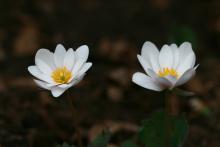
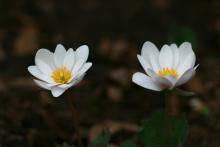
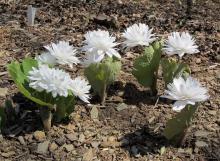
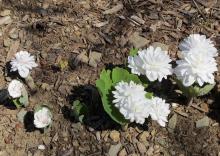
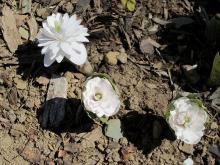
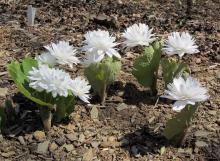
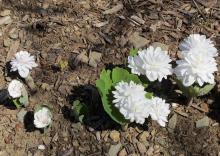
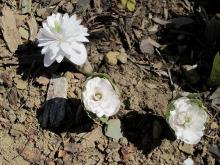
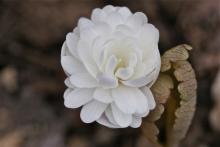
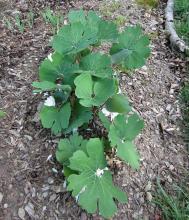
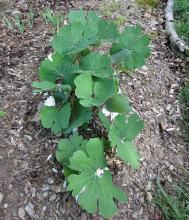
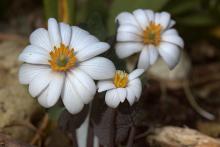
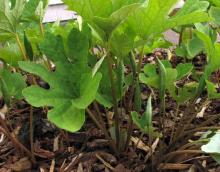
Excellent photos, Mark! Such a fascinating spring ephemeral. It will be a long time until they emerge in my yard (and I only have the species and a small 'Mulitplex' anyway) - I'm very interested in seeing the varied forms that people are growing.
Interesting that there's a little population in South Dakota, disjointed from the rest of the range.